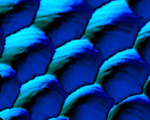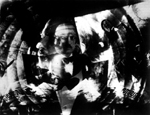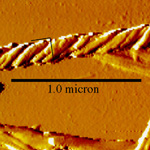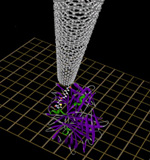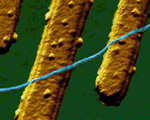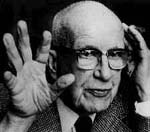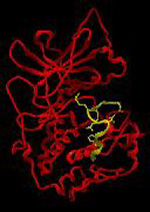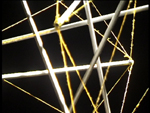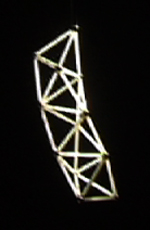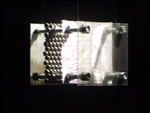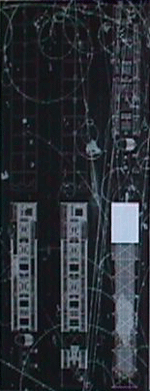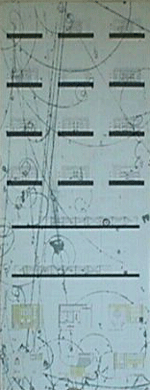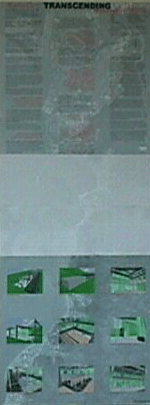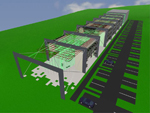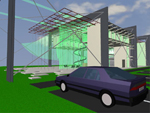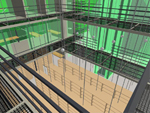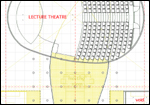universalform...
final year design project... 2001
TRANSCENDING LIGHT...
SEEING BEYOND LIGHT, - ILLUMINATING THE ARCHITECTURAL SUB_SURFACE
EXPLORATIONS INTO THE SUB-ATOMIC IN ARCHITECTURE
EXPRESSING THE UNSEEN ARCHITECTURAL IMPLICATIONS OF THE INVISIBLE ATOM
Current atomic theory can be traced back to the Greek atomists, Leucippus and his pupil Democritus (ca460-371 BC), who first conceived the notion of a universe which consisted of atoms that create all phenomena by colliding into and combining with each other.
The word atom stems from ancient Greek ‘Atomon’ literally meaning “uncuttable”. The Greek concept of Atomos – ‘the indivisible atom’ originated around 440 BC by Leucippus and Democritus.
ERNEST RUTHERFORD – MAKING THE IN-VISIBLE, VISIBLE
It is New Zealand born physicist Ernest Rutherford who is popularly credited with defining the theory for the splitting of the atom – cutting the uncuttable.
The work of physicist Ernest Rutherford, whose early research into nuclear radiation and the nature of matter at the sub-atomic level, formed the foundations of the current structural model of the atom and opened our eyes to a whole new world of material reality.
Awarded the Nobel Prize (in chemistry not physics) in 1908 for his "researches on the disintegration of the elements and the chemistry of radioactive matters", Rutherford defined what ‘radiation’ was (one element turning into another [alchemy], accompanied by a release of radioactive energy), and then proceeded to define the inner workings of the atom.
Rutherfords ultimate act of dividing the indivisible had a resounding effect on the future of humanity He at once defined the atom as an entity, whilst undermining it as the smallest divisible unit of matter.
“…Rutherford is one of the most illustrious scientists the world has ever known. He is to the atom, what Darwin is to evolution, Newton to mechanics, Farraday to electricity and Einstein to relativity.”
John Campbell, ‘Rutherford - Scientist Supreme’ (1999)
Today’s technological environment allows us to perceive matter at a much more intimate scale. Advances in the field of microscopy enable us to ‘see’ the previously ‘unseen’, to perceive what was previously imperceptible. This technology gives us an alternative view of architecture at previously unforeseen levels of clarity and perhaps, understanding.
The apparatus that Rutherford developed for his ‘gold leaf’ experiment in 1909, with its Beam-Target-Decector organisation forms the basic basis for all modern particle accelerator design.
“…Rutherford was an out and out experimentalist, he simply built a machine to break the atom apart.”
(Dr Stephen Hawking, Stephen Hawkings Universe,1999)
Modern particle accelerators use high speed sub-atomic collisions to ‘map’ the form of particles which are smaller than the wavelength of light, and hence beyond the visual range of traditional light microscope. These nuclear microscopes allow us to ‘visualise’ the fundamental structure of matter, giving us the ability to ‘see’ the ‘unseen’ subsurface of matter.
THE IMPERCEPTIBLE SMALLNESS OF ARCHITECTURE: A QUEST FOR THE HIDDEN SENSUALITY OF FORM AND SPACE
"...we should express the infinite smallness that surrounds us, the imperceptible, the invisible, the agitation of atoms, the Brownian movements, all the exciting hypotheses and all the domains explored by the high-powered microscope."
Tommaso Marinetti, 1913 Futurist Manifesto (from, Marcos Novak, ‘transmitting architecture’)
The Italian Futurist movement in the early part of last century, was associated with the application of the aesthetic and the processes of the ‘machine’. They glorified the machine for all its functional beauty, but retained the evolutionary idea of searching for the generative rules at a molecular level.
FULLER – UNDER THE MICROSCOPE
Richard Buckminster Fuller (1895-1983) – inventor, architect, engineer, mathematician, poet and cosmologist, he invented two of the lightest, most stable structures ever designed - the octet truss and the geodesic dome (Kenner).
“I then switched my observation from the macrocosmic to the microcosmic and witnessed that man's probing within the atom disclosed the same kind of discontinuous - compression, continuous - tension apparently governing the atom's structure. That is, the islands of energy concentration of the atom and its nucleus were extraordinarily remote from one another in respect to their measurable local energy concentration diameters, and all were bound together by a comprehensive but invisible tensional integrity.”
(Tensegrity, R. Buckminster Fuller, 1961)
Fullers synergetic rules were developed from mathematical representatons of natural structures. However, his broad, spectacular, utopian, often cosmic, occasionally atomic visions of architecture are remarkably narrow in their built form (i.e. domes).
THE IMMATERIALITY OF GLASS
Glass as a contemporary architectural medium exhibits some remarkable properties, not the least of which is its exquisite transparency, inviting description of its material immateriality, its absence, or its infinity.
The issue of transparency in architecture is a fertile ground of architectural comparison and contrast. It has evolved through expanding analogies, encompassing such notions as translucency, opacity, and reflectivity.
“The weight of matter is archaic (...) it must be overcome”
(Jean Nouvel. Transparences-Traverses, number 35. September 1985, page 72)
“As far as materials are concerned, I believe in the Darwinism in architecture, not in the sense that materials disappear in some way, but in the sense that our materials technology and our control over material will increase, will improve and we will therefore need less and less material to resolve a given job. One of the main ways to control matter is with light”
(Lecture by Jean Nouvel. Entretiens de Vivienne. September, the 24th of 1998)
Introduced into modern architectural debate since Die Gläserne Kette, the presentiment of transparency has been a recurring apparition in modern architecture the last seventy years. Advocated by Sigfried Giedion and differentiated by Colin Rowe, its doctrines seem to have all but exhausted the subject matter. (Transparency Revisited, Mark Lee, 1997)
The properties of glass enable us to play with light as medium, painting it across our buildings, making elements appear or disappear, at the mercy of time, distance and nature. The lightness, the transparency, the backlight, the reflections, the nocturnal views can combine into a rich tapestry of form and space.
The idea that glass, light and microscopy are innately linked lies in glass's unique ability to magnify other materials without revealing its own materiality.
Advances in the field of microscopy enable us to ‘see’ the previously ‘unseen’, to perceive what was previously imperceptible.
EXPLORING THE SUB_SURFACE – EXTRAPOLATING ARCHITECTURAL DENSITY
AN EXPRESSION OF THE UNSEEN SUBSURFACE OF ARCHITECTURE, A JOURNEY FROM SOLID TO VOID
Like a tunnel through space and time, this long, linear structure attempts to amplify the infinite invisible layers of matter at the sub-atomic scale, found between solid and void, darkness and light. A visible reproduction of the fabric of matter via the transition of architectural ‘matter’ through a set dimensional framework.
An amplified composition of standard (both regular and irregular, modular and freeform) architectural parts, assembled (within the experimental framework) to create a linear transition of densities and degrees of enclosure - a linear progression of ‘semi-enclosed’ spaces illuminate the spectrum of degrees between inside and out.
By developing an experimental three-dimensional framework within which can be sculpted, an elongated transitional journey from outside to inside, light to dark, solid to void, in an architectural representation of spatial density, like a visible spectrum of architectural components shifting from solid to void; from 0 to 1 (or vica versa).
The regular frames define a hypothetical three dimensional space, in which any one of an infinite amount of points in space can become either solid or void, forming a blank three dimensional canvas, on which the transitional density of space and form can be painted.
By (primarily) utilising the im-materiality of glass, and various other contemporary and ‘high-tech’ building materials, a transitional density is achieved through a layering of transparent, translucent and opaque materials (glass, mesh and solid).
Subscribing (loosely) to Fullers principles of TENSEGRITY, the whole of the built form exhibits a ‘balanced tension’ of thin, efficient resonant members (steel and glass wires), held in constant tension by strategically placed compressional struts.
Like one of Rutherford’s (perhaps crudely) readymade; functional, experimental apparatus designed to analyse the structure of the atom, this building is an ‘experimental apparatus’ for living in the atomic age – illuminating the unseen in our environment – giving form to the research and analysis of our living earth, at the sub-atomic scale.
THE BUILT FORM – A RESEARCH FACILITY FOR THE INSTITUTE OF GEOLOGICAL AND NUCLEAR SCIENCES (GNS), WELLINGTON
The choice of the Institute of Geological and Nuclear Sciences Limited as client emphasises the sub-atomic nature of their investigations, mapping Geological material and subsurface with the use of sub-atomic tools, allowing us to ‘see’ below the visual boundary of ‘surface’.
Connections to Rutherford both via the formation of their organisation, and in their use of the scientific visualisation techniques he pioneered.
LOCATION
GNS is located at 69 Gracefield Road, Petone. It currently occupies three individual buildings (Hector building, Modriniak building and McKay building) on a site shared with Industrial Research Limited (IRL, another Crown Research Institute), as well as an elevated building site to the east of Gracefield Road (Rafter building).
The Gracefield site was originally built by the American Military as a supply and distribution base during the 1940’s, and has been added to and modified may time to meet the growing needs of the Institute.
The institute of Geological and Nuclear Sciences is responsible for developing an understanding of the constitution, processes and history of the earths SUB_SURFACE.
The organisation is split into two main science groups – the Natural Hazards Group and the Natural Resources Group.
1 - Natural Hazards Group is divided into four sections: Hazards (Earthquakes), Mapping, Volcanoes, and Active Landscapes.
2 - Natural Resources Group is also divided into four sections: Hydrocarbons, Geothermal & Minerals, Geological Time, and Isotope Applications.
GNS currently has approximately 260 staff members.
FACILITIES
In addition to these research facilities; incorporating laboratories, workshops and offices, there are also administration facilities (management, marketing and finance), as well as communal library, lecture theatre and cafeteria facilities.
The site of the Rafter building, to the east of Gracefield Road, houses four large linear particle accelerators, used to date and analyse chemical composition of material samples.
GNS also houses and maintains an atomic clock, which is the official standard timekeeper for New Zealand (NZST).
THE PROPOSAL
The intention was to combine the facilities, currently housed in four separate locations into one single, unified facility, on the site of the existing Rafter Building. This elevated site, which is currently owned by GNS, offers views of the Lower Hutt and across Wellington harbour to the central city.
The new facility should meet all existing functional requirements in a clearly organised and efficient manner, with provision for potential future expansion.
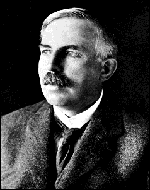
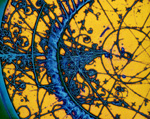
.gif)
